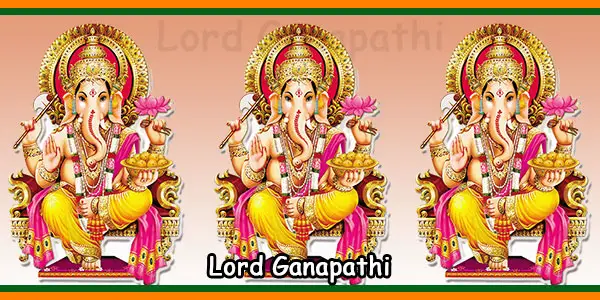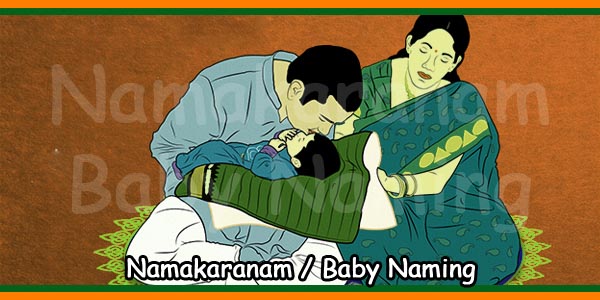Godh Bharai/Shrimantam Sanskar:
The Punsvan Sanskar (Baby Showers) Performed during the period of pregnancy, invoking blessings for Divine protection for his/her bright future. Generally performed Ganesha Puja with chanting of mantras during a Puja strengthens health development of the gross (physical), subtle (mental) and astral (conscious) body of the child.
Godh Bharai is a ceremony that hold utmost spiritual significance in India with different lingual communities having their own name for this Hindu ritual.In Northern India, it is called Godh Bharai, in the East it is called ‘Shaad’ and in the South it is called Shrimantam.

Traditionally, the godh bharai ceremony begins by having the mother-to-be decked up like a bride. She is then made to sit in a place of honor. Then the mother-to-be holds out her ‘palla’ or the draped part of her saree. All the guests bless the pregnant lady and put their gifts in her ‘godh’ or lap. This is where this pregnancy ritual gets it name from. The mother-to-be is also fed delicious foods during the ceremony usually prepared by her mother or mother-in-law. In fact, all her favorite dishes are prepared for the godh bharai ceremony. Every woman who are part of the godh bharai function whisper into the pregnant lady’s ears and say something good about her baby.
The relatives and family members make all kinds of effort to keep the mom-to-be happy and stay smiling always. They receive advices, suggestions and many gifts on this occasion that helps the parents-to-be to get prepared for the arrival of the child. The ceremony is concluded by singing and dancing to celebrate the coming of a new member in the family. This Hindu ritual is carried out during the 7th month of pregnancy. This means that the child is now in a safe. The lap of the mother-to-be is filled with fruits and gifts and blessings from elders. However, the time period varies among different communities. Sometimes, this ritual can also be done in the 8th or 9th month of pregnancy.
The expected mom wears new clothes and her hands are filled with henna designs. Many elders give useful suggestions as the mother is going to enter a new and very important phase of her life after this. The tradition and the way of performing Godh Bharai may differ from one place, state or family to another but the process remains more or less the same. The expecting women takes blessings from God and then from elders and is offered various gifts and presents that are usually for the mom or the child. The basic purpose of a godh bharai ceremony is to give the mother-to-be lots of love and gifts for herself and her baby. Godh bharai is usually an all-women function. Men are not allowed in this ceremony. It is the women of the family who have a gala time centered around the mom-to-be.
Traditionally men did not attend baby shower ceremonies as well but in today’s cosmopolitan environment, they are not left out. Godh bharai is a religious ceremony and not just a gathering of friends like a baby shower. Godh bharai is done on an auspicious date selected by the priests. In some communities a puja is also performed during this ceremony. Apart from being given many generous gifts, the mother-to-be is fed a lot of delicious foods during this ceremony. Like all other Hindu rituals, godh bharai is also an excuse to bring together family and friends to foster a feeling of community. Indians consider any addition to their family as a blessing of God and so celebrate all such occasions with great enthusiasm.
Namkaran Sanskar:
A naming ceremony is the event at which an infant, a youth, or an adult is given a name or names. The timing can vary from mere days after birth to several months or many years afterwards. Some of these ceremonies have religious or cultural significance. The ceremony of naming the child – A sacrament for imposing of divinity in newly-born human child. The Namkaran Sanskar (Naming Ceremony) of the child is normally performed on the tenth day after birth, but can be performed within a month or whenever name is given to child. It is also a sacrament for imposition of divinity in a newly born child.

During this ceremony, the importance and education is given to parent and other family members that the child should be given the atmosphere where his/her inherent qualities can be awakened and undesirable traces of previous birth can be uprooted. The child should be named in a manner that is meaningful and reflects a noble quality. During Namkaran sanskar parents are encouraged that child is also for society & should be encouraged to be friendly with other family members, neighbor & whole world.
Mundan Sanskar:
The Mundan Sanskar (tonsure ceremony) of children – Eradication of beastly tendencies & sowing seeds. It is performed at the age between 1 to 5 years regardless of gender. Nowhere in our scriptures are mentioned the differences between a girl and a boy. In fact, the Vedas say, ” Dash putra sama yasya shilvati soota “, meaning a moral girl is equivalent of ten boys. It aims at eradication of beastly tendencies and sowing seeds of cultural consciousness in the child. It is also performed for harmonious titillation of the nerves and proper development of the brain.
It is said that birth hair carries undesirable ideas and traits from past birth. So they need to be removed and new ideas full of eminence should be grown in its place. Parents are given education that the success of life is in using our talents, capabilities, and intelligence to benefit the world. Please speak to one of us for performing Mundan Sanskar.
Yagnopaveetham Sanskar / Janoi:
ॐ भूर्भुवः स्वः तत्सवितुर्वरेण्यं भर्गो देवस्यः धीमहि धियो यो नः प्रचोदयात्
The sacred thread ceremony – Installation of the principles of Indian culture – taking pledge to lead disciplines, dignified spiritual life. The most important sanskar for teenagers and youth , regardless of gender. It indeed gives “new birth” ( dwijatva ) to a person.
The development of personality coherent with the dignity of human-being begins only after one adopts certain moral values and disciplines of humanity and enlightens his/her mind as well as inner self. The Yagyopaveet sanskar is performed to channelize this development . The initiation of the Gayatri Mantra and experiments of spiritual elevation is associated with this sanskar .

